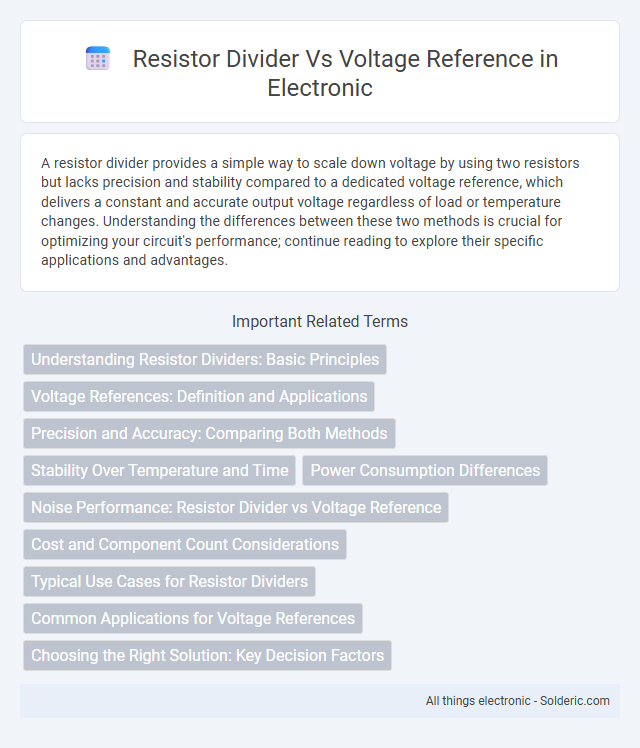A resistor divider provides a simple way to scale down voltage by using two resistors but lacks precision and stability compared to a dedicated voltage reference, which delivers a constant and accurate output voltage regardless of load or temperature changes. Understanding the differences between these two methods is crucial for optimizing your circuit's performance; continue reading to explore their specific applications and advantages.
Comparison Table
| Feature | Resistor Divider | Voltage Reference |
|---|---|---|
| Purpose | Simple voltage scaling | Stable, precise voltage output |
| Accuracy | Low to moderate, depends on resistor tolerance | High, designed for precision |
| Stability | Low; affected by temperature and load | High; temperature compensated |
| Output Noise | Minimal; mainly resistive noise | Very low; designed for low noise |
| Load Regulation | Poor; output varies with load current | Excellent; stable regardless of load |
| Power Consumption | Low; passive components | Higher; requires power for active regulation |
| Complexity | Simple, low cost | Complex, higher cost |
| Typical Applications | Basic voltage scaling, analog inputs | Precision ADC references, instrumentation |
Understanding Resistor Dividers: Basic Principles
A resistor divider consists of two resistors connected in series, creating a specific voltage output that is a fraction of the input voltage based on the ratio of the resistors. This simple circuit relies on Ohm's Law and the principle of voltage division to provide a predictable voltage drop without active components. While resistor dividers are cost-effective for generating reference voltages, their output can vary significantly with changes in load current and temperature, limiting precision compared to dedicated voltage reference devices.
Voltage References: Definition and Applications
Voltage references provide a precise and stable output voltage, essential for accurate measurements and reliable circuit operation in devices such as analog-to-digital converters and power management systems. Unlike resistor dividers, which depend on resistor ratios and can vary with temperature and supply changes, voltage references maintain consistent voltage regardless of load or input fluctuations. Understanding the role of voltage references ensures Your designs achieve optimal performance and stability in sensitive electronic applications.
Precision and Accuracy: Comparing Both Methods
Resistor dividers offer simplicity but suffer from limited precision due to resistor tolerance and temperature variations, making them less reliable for exact voltage regulation. Voltage references provide superior accuracy and stability through bandgap or buried-zener technologies, maintaining consistent output despite changes in load or temperature. Choosing between them depends on the application's precision requirements, with voltage references preferred for high-accuracy circuits and resistor dividers suited for low-cost, less critical tasks.
Stability Over Temperature and Time
Resistor dividers experience significant voltage drift due to resistance changes caused by temperature fluctuations and long-term aging, making them less stable for precision applications. Voltage references employ bandgap or buried zener technologies that maintain a stable output voltage despite temperature variations and device aging, ensuring high accuracy over time. High-quality voltage references typically guarantee stability within a few parts per million per degree Celsius and maintain performance over thousands of hours.
Power Consumption Differences
Resistor dividers consume continuous power proportional to the voltage drop and resistor values, leading to higher energy loss, especially at low loads. Voltage references incorporate active circuitry that regulates output voltage with minimal current draw, significantly reducing overall power consumption. Selecting voltage references over resistor dividers is critical in battery-powered and low-power applications to optimize energy efficiency.
Noise Performance: Resistor Divider vs Voltage Reference
Resistor dividers generate noise primarily due to thermal noise from resistors, which increases with higher resistance values, leading to less stable output voltage in sensitive circuits. Voltage references incorporate low-noise bandgap or buried Zener technologies, offering significantly lower noise density and superior voltage stability. Choosing a voltage reference over a resistor divider is crucial in precision applications demanding minimal noise and high accuracy.
Cost and Component Count Considerations
Resistor dividers offer a low-cost solution with minimal component count, making them ideal for basic voltage scaling applications where precision is less critical. Voltage references, while more expensive and requiring additional components, provide stable and accurate output voltages essential for precision circuits. Your choice depends on balancing cost efficiency against the need for voltage stability and accuracy in your design.
Typical Use Cases for Resistor Dividers
Resistor dividers are commonly used for scaling down high-voltage signals to lower levels compatible with microcontrollers or analog-to-digital converters. They provide a simple, cost-effective method for voltage measurement and sensor signal conditioning in applications such as battery monitoring, voltage level shifting, and feedback control loops. Although less precise than dedicated voltage references, resistor dividers are ideal in circuits where accuracy can be traded for simplicity and flexibility.
Common Applications for Voltage References
Voltage references are essential in precision circuits where stable and accurate voltage outputs are critical, such as analog-to-digital converters (ADCs), digital-to-analog converters (DACs), and sensor calibration systems. Unlike resistor dividers, voltage references provide consistent output despite variations in temperature, supply voltage, and load conditions, making them ideal for high-accuracy measurement and control applications. Your designs will benefit from voltage references in environments requiring reliable voltage stability and minimal drift over time.
Choosing the Right Solution: Key Decision Factors
Choosing the right solution between a resistor divider and a voltage reference depends on factors such as required accuracy, stability, and power consumption. Resistor dividers offer simplicity and low cost but suffer from voltage drift and limited precision, while voltage references provide high accuracy and stable output under varying conditions. Your selection should align with the application's tolerance for error and environmental factors to ensure optimal circuit performance.
Resistor divider vs voltage reference Infographic

 solderic.com
solderic.com